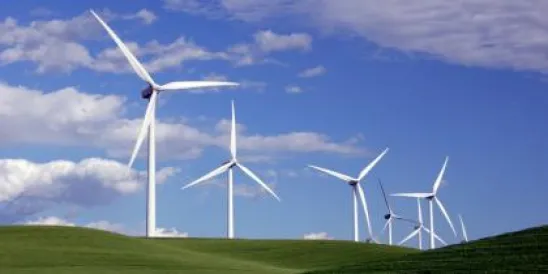Tom Burton, Chair of Mintz Levin’s Energy Technology Practice, will publish a weekly installment providing insight into the challenges and possible solutions that, if implemented, promise a bright future as clean energy moves America forward. In this series, Tom will include one challenge per week and the potential solution(s).
The Problem: Supply and Demand Geographic Mismatch
Because much of America’s renewable energy supply is inland and demand is on the coasts (about 52% of the U.S. population is coastal), demand cannot meet supply without extensive transmission networks. For instance, about 60% of the nation’s wind energy is produced inland – Texas alone accounts for 25%. However, states and localities have many different rules regarding the siting of these lines, making project development complex. While the Federal Power Act (FPA) grants the Federal Energy Regulatory Commission (FERC) authority to regulate electricity transmission in interstate commerce as well as the sale of electricity for resale, it reserves all other authorities to the states.
-
Recently, the D.C. Circuit Court of Appeals used the FPA to invalidate a FERC Order encouraging demand response because states have jurisdiction over interstate transmission.
-
In 2014, Ohio enacted a bill to revise the setback distance to a minimum of 1,125 feet from the nearest property line. Several proposed wind farms were immediately off the table, and had the Blue Creek Wind Farm not been grandfathered in, only 12 of its 152 turbines would have been able to be built. The case shows that the complicated nature of regulations has implications for renewable energy development beyond transmission alone.
-
CapX2020 was a Minnesota project involving several utilities that wanted to expand transmission for wind development. It took over 11 years to complete, in part due to a state law known as “Buy the Farm,” which allows landowners to require utilities purchase their entire property outright. CapX required negotiations with over 2,000 landowners, about 100 of whom requested buy the farm and have negotiated over many years. If this continues, renewables will truly “buy the farm.”
Obviously, the rules need to change, but how?
Solution: Federal Preemption
Congress can and should have a comprehensive response to transmission issues through federal preemptive legislation. Through the Constitution’s commerce and supremacy clauses, Congress has clear authority to regulate and eliminate costly, time consuming, and unpredictable state and local laws. The Supreme Court agrees: as it concluded over 30 years ago in FERC v. Mississippi, “it is difficult to conceive of a more basic element of interstate commerce than electric energy, a product used in virtually every home and every commercial or manufacturing facility. No State relies solely on its own resources in this respect.” The Court authorizes preemption in three scenarios: when Congress expressly states preemption, when local laws directly conflict with federal laws, or when federal law effectively occupies an entire field, leaving no room for state/local activity. There are several examples of precedent:
-
The Natural Gas Act of 1938 (NGA) was the first instance of federal government regulation in the natural gas industry. The NGA put wholesale natural gas transactions squarely within the jurisdiction of federal regulators. While the Supreme Court examined the law’s scope with respect to retail sales this spring in ONEOK v. Learjet, it affirmed federal supremacy in cases that are purely wholesale, which the NGA directly addresses.
-
In response to concerns about uncontrolled releases of hazardous substances, Congress in 1980 enacted the Comprehensive Environmental Response, Compensation, and Liability Act (CERCLA). Although CERCLA doesn’t completely displace state and local laws, it does exempt actions under the statute from the requirement to seek federal, state or local permits, and it also preempts pre-enforcement judicial review of those actions.
-
In 2012, Congress expanded the FCC’s reach under the Telecommunications Act of 1996, due to local interference with wireless communication tower siting.
For more, read Ann Klee, Jeffrey Porter, and Katy Ward’s analysis in Gas Lines to Pipelines: The Case for Comprehensive Federal Energy Legislation.
Solution: Deploy Offshore Wind
In contrast to onshore energy, offshore wind resources tend to be located relatively near coastal population centers. Transmission is still needed to connect projects to the onshore grid, but distances are much shorter and often cross many fewer jurisdictions and utility service territories than onshore projects.
-
Offshore wind has enormous potential – according to the National Renewable Energy Laboratory (NREL), U.S. waters could produce over 1000 GW of energy. The benefits of offshore wind include: meeting Renewable Portfolio Standard mandates, increasing reliability, reducing transmission costs, and reducing peak demand.
-
Deepwater Wind is on track to build the country’s first offshore wind farm on Block Island, RI. In March, the 30 MW project, encompassing the entire Block Island renewable energy area, closed on a $290 million financing round. Deepwater will build the turbines in state waters approximately 2.5 nautical miles southeast of Block Island, while the transmission cable will cross federal waters in the Atlantic. During the summer of 2015, the latticework jacket foundations for the turbines were installed. The turbines themselves will follow next year and the wind farm is expected to be operational in late 2016.
-
The Atlantic Wind Connection is an offshore, undersea transmission line that will span the mid-Atlantic region from New Jersey to Virginia. The transmission line will connect wind farms that are built in the federally-designated “Wind Energy Areas,” at least ten miles off the coast, simplifying permitting. The project, co funded by Google Energy, is split up into three phases over a ten year period: New Jersey Energy Link, Delmarva Energy Link, and Bay Link. Last year, developers announced plans to move ahead with phase I, but are still waiting on regulatory approval from agencies including the Bureau of Ocean Energy Management. When complete, it will support up to 6,000 MW of offshore wind energy.




 />i
/>i

